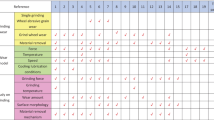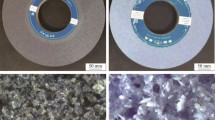Abstract
In order to study the friction and wear properties of cast iron in free grinding environment under the condition of line contact, this paper presented a new method to calculate the friction coefficient by measuring the friction torque. Through the self-developed free abrasive grinding experimental device in line contact condition, this work carried out friction and wear experiment with relative speed, load, abrasive particle diameter, and abrasive mass fraction as process parameters, and studied the evolution rules of friction coefficient and wear amount of cast iron materials under different process parameters. Based on the response surface method Box-Behnken experimental design, the significance of the experimental results was analyzed, and the prediction model of the friction coefficient and wear amount of cast iron was established. According to the significance of the prediction model, the influence degree of each process parameter on the friction coefficient and wear amount was revealed. The results showed that under the action of free abrasive, the friction coefficient of cast iron material in line contact with GCr15 was between 0.18 and 0.35. When the experimental time was 1.5 h, the removal amount of cast iron material was between 20 and 65 mg, which is significantly increased compared with that without abrasive and the wearing capacity of cast iron increased with the increase of relative speed, load, abrasive particle diameter, and abrasive mass fraction. The friction coefficient had a negative correlation with relative speed, and a positive correlation with abrasive particle diameter and abrasive mass fraction. With the increase of load, the change of friction coefficient decreased first and then increased. The influence degree of each process parameter on the friction coefficient and wear amount of cast iron material: the particle diameter and relative velocity of abrasive were relatively significant, the abrasive mass fraction was the second, and the load was the smallest. Through random experiments, the prediction model of friction coefficient and wearing capacity were verified to be highly accuracy, and could be used to predict the friction and wear performance parameters of cast iron in the process of free grinding under the condition of line contact. It provided a certain theoretical basis for the friction and wear behavior of cast iron as a grinding tool material in the grinding process.






















Similar content being viewed by others
Data availability
The data presented and/or analyzed during the current study are available from the corresponding author on reasonable request.
Code availability
Not applicable.
References
Da Silva RB, Lima MLS, Machado AR (2018) A surface and sub-surface quality evaluation of three cast iron grades after grinding under various cutting conditions. Int J Adv Manuf Technol 99(5–8):1839–1852
Ukar E, Lamikiz A, Tabernero I (2014) Polishing of ductile cast iron with scan-head guided fiber laser. Adv Mater Process Technol-mesic V 797:151–156
Dong LH, Fan CH, Yang H (2006) Study on the grinding mechanism of polishing film. Adv Grind Abras Technol XIII 304–305:330–334
Da Silva LRR, Costa HL (2017) Tribological behavior of gray cast iron textured by maskless electrochemical texturing. Wear 376:1601–1610
Raymond N, Soshi M (2017) Sliding performance of machined grey cast iron surfaces after compliant abrasive surface polishing. Int J Adv Manuf Technol 90(9–12):3483–3496
Li QJ,Wang CY, Zheng LJ, Wang YJ, Song YX (2012) The key technologies and advanced of ultra-precision single-plane polishing and lapping devices. Adv Mater Res 565:261–266(ISAAT2012)
Tang CJ, Neves AJ, Fernandes AJS, Gracio J, Ali N (2003) A new elegant technique for polishing CVD diamond films. Diam Relat Mater 12(6):1411–1416
Zeng YB, Liu C, Cheng GS, Zhao ZG, Guo H (2013) High-quality quartz thin film prepared by lapping and Chemical & Mechanical Polishing Technology. Chin J Sensors Actuators 26(01):1–6
Yuan JL, Wang ZW, Hong T, Deng QF, Wen DH, Lv BH (2009) Semi-fixed abrasive machining technique. J Micromech Microeng 19:1–7
Wei Y, Yuan JL, Lv BH, Deng QF, Liu D (2011) Analysis on sliding state of ball in rotated dual-plates lapping mode. Adv Mater Res 317–319:345–349
Deng XF, Chen G, He CL, Zheng RC, Cai ZJ, Wang ZQ, Jin XM (2021) Properties of grinding tool material for double-disc straight-groove grinding method based on friction and wear experiment. Int J Adv Manuf Technol 114(7):2243–2259
He YL (2014) Research on the double disc and eccentric straight groove lapping method for cylindrical roller. Tianjin University; Dissertation
Chen Y (2020) Research on rotating motion of cylindrical roller based on double-disc straight groove grinding. Tianjin University; Dissertation
Ren CZ, Su YX, Chen G, Liang L, He CL, Geng K, Yan CB, Jin XM (2022) Grinding tools kit, equipment and method for finishing the rolling surface of spherical rollers. Tianjin: CN202110885924.4
Ren CZ, Geng K, Liu WF, Chen G, He CL, Su YX, Yan CB, Jin XM (2022) Grinding tools kit, equipment and method for finishing the rolling surface of cylindrical rollers. Tianjin: CN202110885327.1
Ren CZ, Zhang YH, Chen G (2018) The invention relates to a grinding disc, equipment and method for finishing the rolling surface of cylindrical rollers. Tianjin: CN201821210321.4
Huang ZY, Zhai HX, Li MQ, Liu XH, Zhou Y (2014) Friction behaviors and effects on current-carrying wear characteristics of bulk Ti3AlC2. Tribol Trans 57:300–307
Lancaster JK (1990) A review of the influence of environmental humidity and water on friction, lubrication and wear. Tribol Int 23(6):371–389
Jun T, Wang XF (2017) Crystal structure and morphology of β-HMX in acetone: a molecular dynamics simulation and experimental study. J Chem Sci 129(4):495–503
Lafaye S, Mr T (2006) On the friction behaviour in nanoscratch testing. Wear 261(7–8):905–913
Xie Y, Bhushan B (1996) Effects of particle diameter polishing pad and contact pressure in free abrasive polishing. Wear 200(1–2):281–295
Preston FW (1927) The theory and design of plate glass polishing machines. J Soc Glass Tech 11:214
Zhang F (2007) Study on Elastically constrained and dissociated abrasive polishing for ultra-smooth surfaces. Jilin university; Dissertation
Kuide Q, Brij M, Chang WP (2004) A cheiilical mechanical polishing model incorporating both the chemical and mechanical effects. Thin Solid Films 446:277–286
Wang J (2009) Robust parameter optimization for multi-response using response surface methodology. Tianjin university; Dissertation
Funding
This work was supported by the National Natural Science Foundation of China (No. 52075381), National Natural Science Foundation of China (No. 51935008), and National Key R&D Program of China (No. 2018YFB2000401).
Author information
Authors and Affiliations
Contributions
Yongxiang Su: writing-original draft preparation, methodology, experiment, data collection and curation, results analysis, formal analysis; Guang Chen: writing-review and editing, conceptualization, supervision, project administration; Yuchong Chang: experimental work, data collection; Qian Gao: review and editing, supervision, results analysis; Chengzu Ren: review and editing, supervision, formal analysis.
Corresponding author
Ethics declarations
Competing interests
The authors declare no competing interests.
Additional information
Publisher's note
Springer Nature remains neutral with regard to jurisdictional claims in published maps and institutional affiliations.
Rights and permissions
Springer Nature or its licensor (e.g. a society or other partner) holds exclusive rights to this article under a publishing agreement with the author(s) or other rightsholder(s); author self-archiving of the accepted manuscript version of this article is solely governed by the terms of such publishing agreement and applicable law.
About this article
Cite this article
Su, Y., Chang, Y., Chen, G. et al. Study on friction and wear properties of cast iron material in line contact condition based on free abrasive grinding experiment. Int J Adv Manuf Technol 124, 3275–3292 (2023). https://doi.org/10.1007/s00170-022-10659-5
Received:
Accepted:
Published:
Issue Date:
DOI: https://doi.org/10.1007/s00170-022-10659-5




